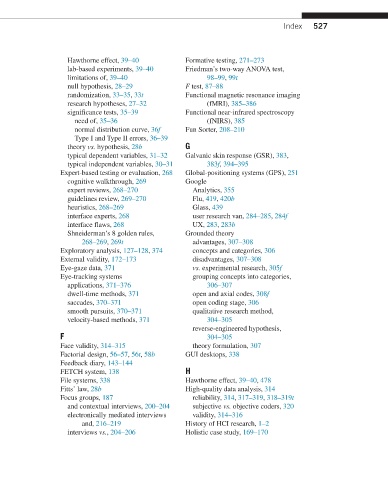Page 534 -
P. 534
Index 527
Hawthorne effect, 39–40 Formative testing, 271–273
lab-based experiments, 39–40 Friedman’s two-way ANOVA test,
limitations of, 39–40 98–99, 99t
null hypothesis, 28–29 F test, 87–88
randomization, 33–35, 33t Functional magnetic resonance imaging
research hypotheses, 27–32 (fMRI), 385–386
significance tests, 35–39 Functional near-infrared spectroscopy
need of, 35–36 (fNIRS), 385
normal distribution curve, 36f Fun Sorter, 208–210
Type I and Type II errors, 36–39
theory vs. hypothesis, 28b G
typical dependent variables, 31–32 Galvanic skin response (GSR), 383,
typical independent variables, 30–31 383f, 394–395
Expert-based testing or evaluation, 268 Global-positioning systems (GPS), 251
cognitive walkthrough, 269 Google
expert reviews, 268–270 Analytics, 355
guidelines review, 269–270 Flu, 419, 420b
heuristics, 268–269 Glass, 439
interface experts, 268 user research van, 284–285, 284f
interface flaws, 268 UX, 283, 283b
Shneiderman’s 8 golden rules, Grounded theory
268–269, 269t advantages, 307–308
Exploratory analysis, 127–128, 374 concepts and categories, 306
External validity, 172–173 disadvantages, 307–308
Eye-gaze data, 371 vs. experimental research, 305f
Eye-tracking systems grouping concepts into categories,
applications, 371–376 306–307
dwell-time methods, 371 open and axial codes, 308f
saccades, 370–371 open coding stage, 306
smooth pursuits, 370–371 qualitative research method,
velocity-based methods, 371 304–305
reverse-engineered hypothesis,
F 304–305
Face validity, 314–315 theory formulation, 307
Factorial design, 56–57, 56t, 58b GUI desktops, 338
Feedback diary, 143–144
FETCH system, 138 H
File systems, 338 Hawthorne effect, 39–40, 478
Fitts’ law, 28b High-quality data analysis, 314
Focus groups, 187 reliability, 314, 317–319, 318–319t
and contextual interviews, 200–204 subjective vs. objective coders, 320
electronically mediated interviews validity, 314–316
and, 216–219 History of HCI research, 1–2
interviews vs., 204–206 Holistic case study, 169–170

